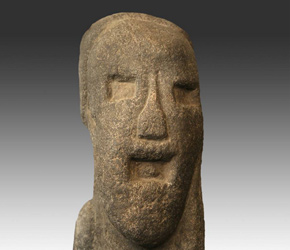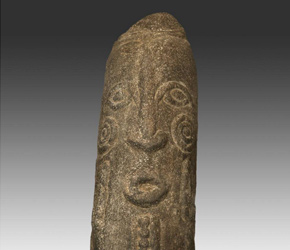African Stone Monoliths
 |
|
"Akwanshi are commonly known as ancestor figures to the people in the grasslands of Cameroon, West Africa. The name Akwanshi literally means 'dead person in the ground'"
Considered by many to be one of the cradles of civilization, Africa is just beginning to yield some of its archeological secrets to the modern age. As recently as the early 1960s, 39 new sites containing 295 carved stone boulders or monoliths were discovered in an area northwest of Ikom in southeast Nigeria. The stones were arrayed mostly in circular groups facing each other (somewhat reminiscent of Stonehenge). The monoliths, many of which carry elaborate carvings of faces and geometric figures, stand one to six feet high and were carved from native basalt or volcanic rock.
 |
|
The Ekoi-speaking Ejagham people, who live in this region, call them Akwanshi, which literally means “dead person in the ground,” suggesting they are memorials for ancestors. The Ekoi are divided into 7 main clans, and it has been further suggested that different monolith styles may coincide with various clan attributes such as tribal marks, tattooing or body painting traditions. This research pertains primarily to the Akwanshi found on the Nigerian side of the Cross River. Far less is known about the Akwanshi monoliths from neighboring Cameroon, the actual geological source of the Cross River, and the area where this Akwanshi originated.
Despite existing scholarship the role of Megalithic monuments in general remains puzzling. South of the Sahara desert such monuments have been found in Senegal, Nigeria, Cameroon, Central African Republic, Ethiopia and northern Kenya, but while many authors have noted and described them, their significance, history, function, date of construction and the culture to which they are attached has remained elusive. The megalithic monuments of Cameroon, while related to those in neighboring areas, may be distinctive to the chiefdoms of the NW Cameroon Grass fields. As such, this monolith cannot be expected to resemble exactly monoliths found elsewhere.
In regard to the monolith above: this male figure (as suggested by its genitalia) is related to the phalli form monoliths from the west, but displays almost rectangular apertures for its eyes and commanding mouth. It carries a bladed weapon in its left hand and an unidentified tool or implement in its right. Oddly, although it is male it appears pregnant. Especially noteworthy is the figure’s detailed coiled hairstyle visible from the rear, which brings to mind the “spiral motifs” of the better-known Nigerian Ikom or Ekoi figures.
 |
 |
As scholars learn more about early African civilizations, it is clear that present-day tribal or even national boundaries are almost meaningless when we consider the long expanse of time since the creation of these monoliths. Even in our lifetimes, we constantly have to update the names of African national and tribal groups and their boundaries. It is clear that stone monoliths can be found in several African nations, Cameroon among them. There are some scholars who make a compelling case that these stones are related to astronomical as well as religious activities instead of ancestor veneration; much like Stonehenge may have been in England.
 |
|
All this raises more questions than answers about these striking stone carvings. What can be said with certainty is their visual power and spiritual resonance serve as a reminder of the highly developed cultures that have preceded us on the planet. These so called primitive peoples left evocative, stylistically sophisticated evidence of their military, social and religious lives, ancestral past, tribal struggles – and their collective spiritual aspirations for the future.
{module_literature,i,138665}
Download this Article: A Chair To Hang Your Hat On.pdf
Download this Article: A Different Kind of Flame - Indian Oil Lamps.pdf
Download this Article: AdobePDF.pdf
Download this Article: A Flying Legacy.pdf
Download this Article: Akshobya Nepalese Buddha.pdf
Download this Article: Akshobya Nepalese Buddha.pdf
Download this Article: Akwanshi.pdf
Download this Article: A Long Lineage.pdf
Download this Article: Amitabha Dhyani Buddha.pdf
Download this Article: An Ancient Language - Christian Art in Ethiopia.pdf
Download this Article: A New Spin On An Old Debate.pdf
Download this Article: Antique Chinese Furniture.pdf
Download this Article: Appreciating Buddhist Art Part One.pdf
Download this Article: Appreciating Buddhist Art Part Three - Bodhisattvas.pdf
Download this Article: Appreciating Buddhist Art Part Two - Dhyani Buddhas.pdf
Download this Article: Appreciating Gongshi Part One – Early Standards and Scholars Rocks.pdf
Download this Article: Archaic Chinese Ceremonial Blades.pdf
Download this Article: Archaic Chinese Cong Form Vase.pdf
Download this Article: Archaic Chinese Hard Stone Artifacts.pdf
Download this Article: Archaic Chinese Hard Stone Bi.pdf